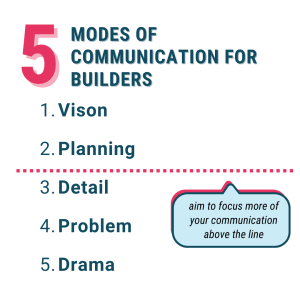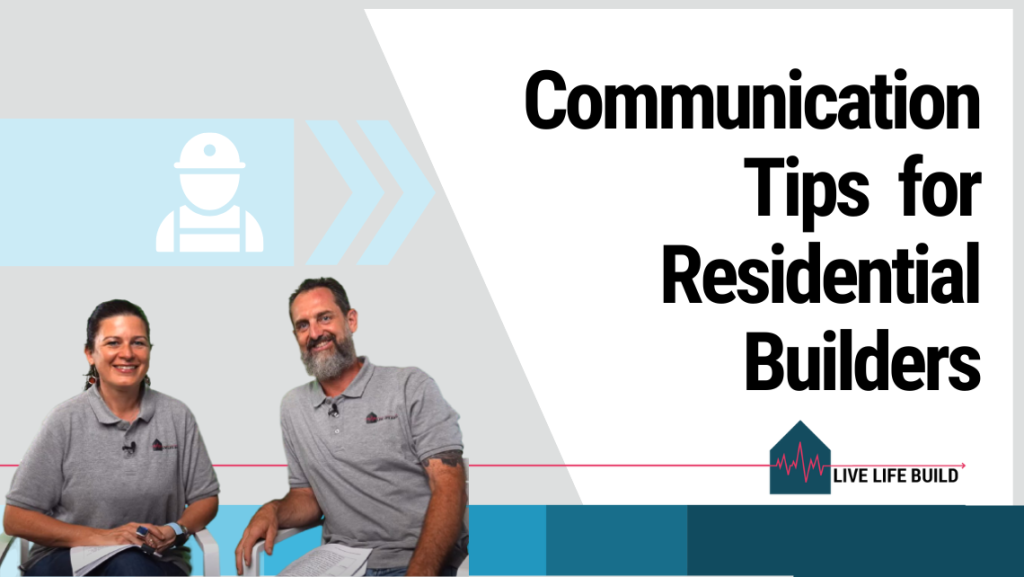How do you rate your communication skills?
Here are 4 tips you can use for better communication with your clients. Number 4 is a GAME-CHANGER!
Watch the video now, or read the transcript below. Be sure to also subscribe to our YouTube channel www.youtube.com/@LiveLifeBuild
Duayne
All right, this one’s an interesting one Amelia, because you will know very well, with all the work you do with homeowners and stuff that dealing and communicating with a builder can be very frustrating. It’s not something that even is on your radar.
Tip 1 – Understand the Importance of Communication
Duayne
We were taught to be builders. And so it can get very frustrating. It can lead to a lot of issues and things. So do you have any tips for builders on ways that they can better communicate to help set expectations for their clients and what to consider?
Amelia
I think the first thing is actually realising how critical it is to your ability to be a good builder and to have good relationships with everybody that you’re working with.
We’re not taught as humans how to communicate.
It’s something that we learn incidentally, through our lives. Sometimes we might benefit from some formal education around that. But when you look at construction litigation, and the amount of lawsuits that exist, communication is actually at the core of most of them.
The problem with communication is what sits at the base of most construction litigation. And when it comes to building a home, a homeowner perhaps has never done this before, and might only do this once or twice in their life. They can walk into that process, and as a builder, I think you can fall into the trap of believing that there’s a bunch of things that the homeowner is supposed to already know. You can make a whole series of assumptions about what there is. Homeowners can also make assumptions about how they think the process can go based on what self education they’ve done, or where they’ve got their information from.
Tip 2 – Don’t Let Little Problems Become BIG Problems
Amelia
Unless communication is actually happening in an open, honest, transparent way on a regular basis, you just can end up in really messy places very, very quickly. And these small problems, which I see time and time again, are small little niggles for homeowners that really could have been dealt with with a very simple phone call or conversation. They then escalate into these big, big challenges for builders to have to deal with. And we see it time and time again.
Duayne
It just opens up big cans of worms.
Amelia
And builders just getting themselves into so much trouble because they didn’t know how to communicate effectively. I see homeowners that are really worried about being too confrontational. A lot of homeowners will enter that relationship with a builder, really nervous to speak their mind, particularly if they’re female, and they’re working inside this male dominated industry, they can struggle to feel like they have a voice. Some builders obviously make the mistake of not acknowledging them in the conversation, they’ll deal mainly with the husband, if they’re working with a couple.
And so all of these situations just can build and build and build.
Tip 3 – Work on Your Communication Skills Regularly
Amelia
Communication is this underlying foundation that really needs to be worked on for builders. And if they’re not working on it on a regular basis, then it can cause some dramas.
Duayne
Yeah, like I said, I definitely don’t think that it’s something that’s on our radar. Like we know we have to use contracts, we know we have to price the jobs up. Hopefully builders know they need to schedule jobs and things. But actually learning and understanding about communicating is something I think we probably take it for granted.
And to be honest, I think probably a lot of builders avoid it, because they just want to get in, get the job built, and they probably feel that communicating with their clients gives the client, I guess, more opportunity to ask questions, request variations, and wonder what’s going on with their work. So they probably try to avoid it.
Tip 4 – Follow the 5 Modes of Communication for Builders
Duayne
What’s the five modes of communication that you can tell the builders about?
Amelia
Yeah, so this is actually a really great thing to remember. It’s something I teach homeowners about, and I was personally taught it as a young architect working at Mirvac. And we were taught it as a team. And it transformed the way that we worked as a team. Transformed the way that we did business. And so I see that it’s something that is really simple to remember and fantastically empowering in terms of thinking about communication.
So I was taught this by an executive coach, Josie Thompson. And she told us that the five modes of communication are vision, planning, detail, problem and drama. So if you see those in a list, vision, planning, detail, problem and drama, you need to understand that all communication happens at one of these levels. So it doesn’t matter what type of communication, it can go into one of these five buckets.
Duayne
Well, I’m thinking there’s one there that most builders would know about.
Amelia
Yeah, drama. Drama and problems. Now the thing to know about communication is that the way in which you communicate is generally the communication you get back. So if you’re communicating in vision, or planning, you will often get vision and planning back. That’s generally the tone of communication you get back. If you’re communicating in detail, you’ll get detail back. Same thing with problem and drama.
And you’ll have a friend who comes and literally every time they see you, they just download all the drama in their life, and you find yourself getting sucked into that vortex of oh yeah, yeah. And it becomes this ‘comparison Olympics’ of who’s in the most trouble at the moment. Now, when you think about those five modes of communication, if you put a number against each of them, and I want you to draw a line between two and three, as we have shown below.

Okay, so we’ve got above the line vision and planning, and below the line you have detail, problem and drama. If you want to make progress with your communication, if you want to move things forward and solve problems, you actually need to get your communication above the line. And so the goal of your conversations, the goals of your communication as a builder and working with people, and this can happen, I’ve actually told homeowners this and they’ve gone, oh my gosh, I’m going to try this with my kids. I’m going to try this with my workmates. The whole goal is to get the communication above the line.
Now, that doesn’t mean that every conversation is always about vision and planning. Sometimes you will have to talk in detail, problem and drama, because that’s the nature of the conversation. Sometimes those things are needed to nut things out. But you need to know that to make steps forward, you need to get back up to vision and planning and get above the line.
There’s one way that you get the conversation above the line, and it’s to ask the person a question. And the question is, what do you want to achieve? What are you seeking to achieve?
So if somebody is talking in detail, problem, drama, and you find that you’re just going round and round in circles, and you can’t get them out of it, asking them the question “what are you seeking to achieve?” forces them to get themselves up to vision and planning.
When we were taught this, we all laughed and went, ah, yeah, look, I could see, in principle, it would work. You know, I could see that that might be helpful. Who talks like that? And what we did as an architectural team at Mirvac was we had weekly meetings with all of the project managers on all the projects in Mirvac Design. And so we had these five bullet points up on the wall on a laminated little piece of paper.
And, we had all done this training. And so we would then go around and talk about the various projects. And there were some architects that always got stuck in detail, problem and drama. And so we started then saying, okay, so what are you actually trying to achieve? You know, what’s going on here?
What are you trying to achieve?
That would force them to go, ‘well, I’m wanting to do this’. And so then we could all put our heads together about what would work. What would that look like? What ended up happening was over time, we just started saying “above the line”, “above the line”. And it was really fascinating, because as a team that just became our way of talking with each other. We then took it into the development team, we took it right through the business.
Duayne
It makes so much sense.
Amelia
Yeah, and it’s really interesting. I’ve taught this to homeowners, and they can see that ‘oh, yeah, I can see I get stuck in detail, problem and drama in a site meeting because I’m so nervous about my house’. ‘I’m worried that the builder is not sorting things’. ‘I’m worried that he’s not taking care of me or she’s not taking care of me’. But if you can get that back up to above the line and actually call those builders. Say to them, what are you seeking to achieve? That builder immediately has to start talking in vision and planning that can make a really big difference to communication overall.
Duayne
Yeah well now that is a fantastic tip and some very simple ways for you to get better communication with your clients.
Now that you have seen the benefits of using the 5 modes of communication, as well as other tips for improving your client relationships, you may want to have a look at related articles such as Difficult Client? Or Is It You? And Managing Client Enquiries.
Let us know in the comments below what steps you are going to implement to change the way you communicate with your clients.

